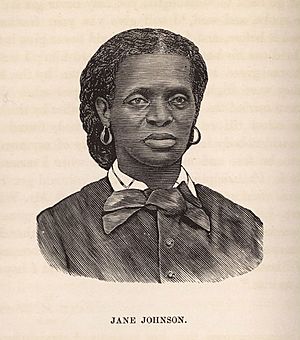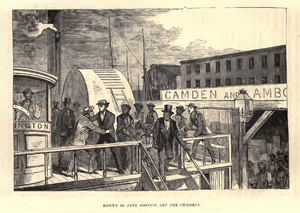Jane Johnson (slave) facts for kids
Jane Johnson was an African-American woman born into slavery around 1814. On July 18, 1855, she bravely gained her freedom with her two young sons while in Philadelphia. She was traveling with her enslaver, John Hill Wheeler, and his family.
Jane was helped by William Still and Passmore Williamson. They were abolitionists who worked to end slavery. Her escape led to important legal cases in Pennsylvania. A judge jailed Passmore Williamson for 90 days because he wouldn't say where Jane and her sons were. This event made many people across the country talk about state and federal laws regarding slavery. Pennsylvania was a free state, meaning it did not allow slavery. Its laws said that if enslavers brought enslaved people into the state willingly, those people could choose to be free.
Jane Johnson later returned to Philadelphia in August 1855. She testified in court during the trial of William Still and five dockworkers. Her enslaver, John Hill Wheeler, had accused them of helping her escape. Jane spoke clearly about her plan to become free in the North. She said she chose to leave with Still on her own, and she would never go back to slavery. Her testimony helped Still and three others be found not guilty. It also led to lighter sentences for two other men. After her testimony, state and local officials protected her. Soon after, she and her sons moved to Boston, where they started a new life. Jane married again there. Her son, Isaiah Johnson, later served in the United States Colored Troops during the American Civil War.
Contents
Early Life and Enslavement
Jane Johnson was likely born as Jane Williams in or near Washington, D.C. Her parents were John and Jane Williams. Not much is known about her early years. She later married a man named Johnson and had children with him.
Around 1853, Jane Johnson and two of her children were sold to John Hill Wheeler. He was a politician and plantation owner from North Carolina. Jane worked as a domestic servant in his home. Sadly, her oldest son had been sold by a previous enslaver to someone in Richmond, Virginia. Jane never expected to see him again.
In 1855, Jane and her sons, Daniel and Isaiah, traveled with Wheeler and his family. Daniel was about 5 or 6 years old, and Isaiah was 11 or 12. They were going by train from Washington, D.C., to New York. Wheeler planned to take a ship from New York to Nicaragua, where he would be a U.S. Minister. On their journey, they stopped overnight in Philadelphia. From there, they would take a steamboat to New York City.
Pennsylvania was a free state, which meant slavery was not allowed there. According to its laws, enslaved people could choose freedom if their enslavers brought them into the state willingly.
Choosing Freedom in Philadelphia
On July 18, 1855, Jane Johnson was staying at Bloodgood's Hotel in Philadelphia. Wheeler had locked her in with her children. She managed to send a message to a Black porter, saying she wanted to escape. The porter quickly told William Still, who led the Vigilance Committee of the Pennsylvania Anti-Slavery Society. This group helped enslaved people find freedom.
Later that day, Wheeler's group was getting ready to board a ferry. Still and Passmore Williamson, another abolitionist, arrived at the docks. Still told Jane that she could choose freedom under Pennsylvania law. Wheeler argued and tried to stop Jane from leaving. Five Black dockworkers held him back while Williamson explained the state law to Wheeler. William Still quickly took Jane and her children away in a coach. He secretly brought them to his house. Still never told Williamson where they were, which was a safety rule used by the Vigilance Committee.
This event became an important challenge to the Fugitive Slave Act of 1850. This federal law required people, even in free states, to help enslavers capture runaway slaves. However, Jane Johnson had chosen freedom in Pennsylvania, which was legal under that state's laws. She was not a runaway from the South; she had been brought into a free state.
Wheeler complained to a federal judge, John K. Kane. Judge Kane ordered Williamson to bring Jane and her sons to court. Kane refused to accept a statement from Jane saying she had left willingly. When Williamson refused to say where Jane was (because he didn't know), Judge Kane found him in contempt of court. Williamson was sentenced to 90 days in jail.
Williamson was jailed from July 27 to November 3, 1855. His imprisonment drew a lot of attention from the anti-slavery movement. He received many visitors, including famous abolitionists like Frederick Douglass and Harriet Tubman. Hundreds of letters poured in, and newspapers across the country covered his case.
Jane Johnson's Testimony and New Life
On August 29, 1855, William Still and the five dockworkers faced charges in a local court. John Hill Wheeler had accused them of causing a riot and assault. Jane Johnson returned from New York, where she had been staying, to testify in court. She entered the courtroom veiled to hide her identity and was with several women abolitionists. They had also arranged for her protection by local and state officials. These officials believed Judge Kane had wrongly gone against state law regarding slavery.
Jane Johnson gave a long statement in court. She explained her plans to gain freedom during that trip. She also corrected false claims made by Wheeler's lawyer. She said:
- "I went away [with Still] of my own free will."
- "I always wished to be free and meant to be free when I came North."
- "I have been comfortable and happy since I left Mr. Wheeler, and so are the children."
- "I don't want to go back... I had sooner die than go back."
Because of her powerful testimony, Still and three of the dockworkers were found not guilty. Two men, John Ballard and William Curtis, were found guilty of assault. They were fined $10 and jailed for a week. A reporter wrote that these men were "very respectable looking persons" and were not sorry for what they did. They would have gladly done it again.
Federal marshals tried to find Jane Johnson, but state and local officials helped protect her. They wanted to resist what they saw as interference with their local laws.
Jane and her children were soon helped to get to Boston. There, northern abolitionists, including Lucretia Mott, kept them safe. They continued to live freely and settled in Boston. Jane married Lawrence Woodford shortly after arriving there, but he passed away in 1861. She married again in 1864 to William Harris. Jane Johnson also helped shelter other enslaved people seeking freedom in Boston at least two times.
Her son, Isaiah Johnson, fought in the American Civil War with the 55th Massachusetts Infantry Regiment, part of the United States Colored Troops. Jane Johnson passed away in 1872 and was buried in Everett, Massachusetts, near Boston.
Representation in Popular Culture
- Jane Johnson's life and escape inspired Lorene Cary to write the novel The Price of a Child (1995).
- Jane Johnson and William Still are featured in the musical Stand by the River (2003), which tells Still's life story and Jane's rescue.
- A fictional version of Jane Johnson's escape appears in Ta-Nehisi Coates' novel The Water Dancer (2019). In the book, Jane Johnson is represented by the character Mary Bronson.



